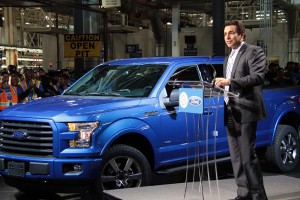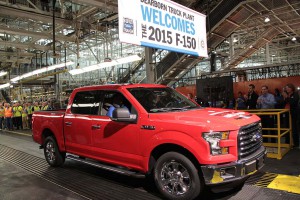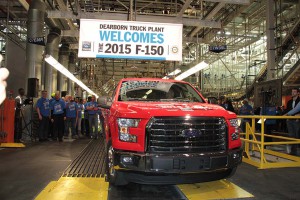
Ford CEO Mark Fields said the new "aluminum intensive" F-150 should send a message to competitors that company intends to remain atop the truck heap.
The long-awaited launch of the 2015 Ford F-150 should send a message to skeptics that Ford will retain its highly profitable leadership in the full-size pickup market, CEO Mark Fields said Tuesday morning as the first of the new, aluminum-bodied trucks rolled off the assembly line.
Ford is taking what many observers have called its biggest risk in decades switching from a traditional, steel-bodied pickup to one that uses an “aluminum-intensive” design. But the benefits, Ford officials stressed, are numerous: better fuel economy, improved towing and larger payload capacity, among them.
“We said this was going to transform this industry,” said Fields, as he stood by the first “saleable” 2015 Ford F-150 to roll off the line at the Dearborn Truck Plant near Detroit. “The proof is this first vehicle.”
Ford produced 647,697 of the trucks last year, with the entire F-Series line-up – including heavy-duty duty versions, such as the F-250 and F-350 – comprising the nation’s top-selling truck for 37 years running. The F-Series is generally considered the top contributor to Ford’s bottom line, and CEO Fields said he didn’t expect that to change.

The first 2015 Ford F-150 rolled off the line today. The automaker is using aluminum to make the truck lighter improving mileage and hauling capacity.
But not everyone is convinced. Some analysts have warned of a slow ramp-up of production, and they have warned that the higher cost of aluminum could drive up production costs.
To prepare for the new F-150, Ford had to make major changes to its big truck plant in the Detroit suburbs – and it is now converting operations at its second F-Series plant near Kansas City. The changeover of the Dearborn Truck Plant alone came to $359 million, with another $484 million going into stamping and other support operations.
But the transition to the 2015 model has also cost Ford in the form of reduced production. For his part, CEO Fields acknowledged that Ford’s competitors have used the transition to close the traditional sales gap – GM’s Chevrolet Silverado and GMC Sierra combined lagging the F-Series by about 100,000 units in 2013.
Ford has said it will put a focus on quality, rather than quantity, as it launches the F-150, Fields noting “We’ll be at full speed in terms of production (only by) the end of the second quarter.”
Even then, not everyone is convinced Ford will be able to maintain sales at the traditional flat-out pace that saw its two plants rolling out a new F-150 at the rate of one every 49 seconds.
There are plenty of questions about the new F-150’s long-term durability and reliability, as well as the cost of ownership – issues of particular concern to the fleet and individual customers who dominate the full-size pickup market and largely use their vehicles for work.
Ford insists it has conducted extensive testing, including computer modeling and 10 million miles of actual testing, and it claims the trucks are more ding and dent resistant than those with steel bodies. The maker is meanwhile racing to get dealers and major independent body shops up to speed about repairing aluminum body panels.
(Ford launches production of new aluminum F-150. For more, Click Here.)
On the positive side, Ford says it expects buyers to be drawn in by the new truck’s improved fuel economy. While official EPA-certified numbers won’t be revealed until later this month, CEO Fields suggested that compared to the old F-150, the new truck should get “between 5 and 20% better mileage…depending on engine.”
The timing of the launch, however, comes as fuel costs slip to their lowest level in at least four years, an estimated 30 states now averaging below $3 a gallon for regular unleaded, according to various tracking services. Longer-term, however, Fields stressed that fuel costs are likely to rise again, and even now, fuel economy is a major factor for truck buyers.
(Click Here for details about Mercedes plans to make sense of its vehicle nomenclature.)
So are the improved towing and payload numbers that come from trimming about 750 pounds off the weight of some new F-150 models.
Ford has been experimenting with aluminum for some years and used the metal on some products sold by its former Jaguar and Land Rover subsidiaries. The F-150 is the first truly high-volume product in the industry to go with an aluminum-intensive design.
(To see more about the slugfest going on between BMW and Mercedes for the luxury sales crown, Click Here.)
Looking forward, Fields said other vehicles could follow. Ford has already confirmed the heavier F-Series Super Duty lines will go aluminum-intensive. And, “We will look at (aluminum) on a case-by-case basis” for other products. The benefits, he noted, are particularly high for larger vehicles, such as pickups and SUVs, where fuel savings can readily offset higher production and purchase costs.
The new F-Series is “important, with a capital ‘I,’”said Fields, if anything an understatement as it will test not just Ford but his own tenure, having assumed the CEO post just four months ago. Ford has only rarely taken such a big risk on a single product. If it succeeds it would likely cement its leadership in the profitable full-size segment. Anything less could pose serious problems for Detroit’s second-largest automaker.



